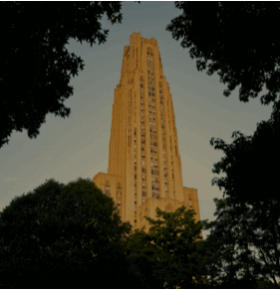
Subscribe to Pittwire Today
Get the most interesting and important stories from the University of Pittsburgh.Pitt-Greensburg’s new benchtop NMR device lets students study molecular structures

From analyzing pond scum to developing new drugs, the ability to study the molecular structures of chemical compounds is a must. And one way to “see” these tiny structures is with nuclear magnetic resonance (NMR) technology.
The National Science Foundation (NSF) has awarded $155,905 to a team led by Jordan Boothe, assistant professor of chemistry at the University of Pittsburgh at Greensburg, for a benchtop NMR spectrometer that will allow the researchers to more accurately study these structures. Boothe and his fellow applicants — Matthew Luderer and Erin Divito, both associate professors of chemistry — are thrilled to have the technology on campus and for Pitt-Greensburg students to gain hands-on instrument experience.
Analogous to MRI, NMR envelopes a sample in a magnetic field. When the field is manipulated, the nuclei of the atoms in a molecule move to align to the field. The length of time it takes for the nuclei to align gives researchers information about the molecule’s shape and size. Atom-by-atom, bond-by-bond, NMR data builds a picture of the sample molecule.
The University’s Pittsburgh campus has several high-powered NMR instruments, which can give extremely accurate results and typically require liquid nitrogen and helium. The new device in Greensburg is a “benchtop model” that can be plugged into a standard outlet with no need for the pricy liquid elements. It’s designed to be undergraduate-friendly, yet sensitive enough to be used for research on the scale that graduate students work with.
“The Greensburg campus has not had this type of NMR instrument for some time,” Boothe said. So, when he and his students need to analyze a sample, they’ve taken the near hourlong trip to Pittsburgh. And though they’ll sometimes still use Pittsburgh’s high-powered instruments for higher-resolution analysis, Boothe said, having the benchtop device will save resources and reduce how often he brings students to the city only to find out the quality of their samples isn’t high enough to give useful data.
“Because we do not have any graduate students or postdocs at our campus, this is very much a teaching instrument,” Boothe said. “But it’s also something I can use for my research.”
In his work, Boothe uses what he refers to as a “pharmaceutical approach” to searching for and desig drugs that can be used to turn microalgae into efficient biofuels.
“And if I'm using NMR for research, if the quality of data that I get from the benchtop model is good enough, I can publish those findings,” Boothe said. “Or, at least I can know whether my samples are pure before I make the trip to Pittsburgh.”
Plus, Pitt-Greensburg students will pick up skills they can directly apply to further study and in their careers.
“This is the same model instrument that a lot of pharmaceutical companies are using,” Boothe said. And it’s a far cry from his first experience with NMR. “I used an old model at my community college that was from the ’70s or ’80s. We had to put a tube into a spinner and physically spin it. It was like a Volkswagen Rabbit, and these students just got a Lambo. I can’t even comprehend the difference.
“But we’re here because of the students, right? We love teaching. We love getting our students involved. It’s really exciting.”
This equipment was funded by a grant from the NSF.
Photography by Jordan Boothe

